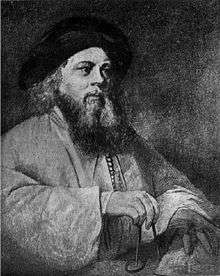Baal Shem of London
| Baal Shem of London | |
|---|---|
 Variations of this portrait, originally subtitled "Baal Shem", are popularly used to represent Israel Baal Shem Tov. Instead it is held to depict rather, Rabbi Falk, the Baal Shem of London[1] | |
| Personal details | |
| Birth name | Hayyim Samuel Jacob Falk |
| Born | 1708 |
| Died | 17 April 1782 (aged 73–74) |
Rabbi Dr Hayyim Samuel Jacob Falk (Hebrew: חיים שמואל יעקב פאלק; Also known as the Baal Shem of London and Doctor Falckon; 1708 – 17 April 1782) was a rabbi, Practical Kabbalist and alchemist.
Early life
Falk was born in either Fürth in Bavaria or Pidhaytsi in Podolia. After having narrowly escaped being burnt at the stake by the authorities in Westphalia who had charged him with sorcery, the German Count Alexander Leopold Anton von Rantzau secretly gave him refuge in Holzminden. During this stay in 1736, Falk made his impressive kabbalistic performances in Rantzau’s castle witnessed by noblemen and Alexander’s son Count Georg Ludwig Albrecht von Rantzau. In his famous Mémoires du comte de Rantzow [2] which are referred to by many researchers as an original standard source this young Count gives a thorough and detailed account of all these mystic demonstrations. Sometime after 1736, Falk arrived in London. He lived at 35 Prescott Street, London, United Kingdom and at Wellclose Square, London until his death. He was a neighbour of Emanuel Swedenborg and there is some evidence that he had a significant influence on him.[3]
Folklore surrounding Falk
Many stories exist regarding Falk's extraordinary powers. According to one account, Falk made secretive visits to Epping Forest in his carriage, where he was said to have buried some treasure. On one of these occasions a wheel came loose from the vehicle on the Whitechapel Road, but followed the carriage all the way to the forest. When Falk ran short of coal, he was said to have performed a magical feat involving three shirts and a ram's horn.[4] Falk was also able to keep candles burning miraculously, and to transport objects from one place to another.
Some claimed that he had saved the Great Synagogue from fire by writing something in Hebrew on the pillars of the door.
Jewish opinion of Falk
Falk bequeathed in his will an annual sum of 100 pounds to the Great Synagogue (Duke's Place), London as well as some Sefer Torahs.
Rabbi Jacob Emden accused him of being a Sabbatean, a supporter of Sabbatai Zevi, as he invited Moses David of Podhayce, a known Sabbatean with connections to Jonathan Eibeschutz, to his home.[5]
Diary and Biography
Falk kept a diary containing records of dreams and the Kabbalistic names of angels. This can be found in the library of the United Synagogue in London. In 2002 Michal Oren published the diary and a biography of Falk.[6] The diary is written in Hebrew and is very cryptic. The diary was published together with the diary of Falk's assistant, Tsvee Hirsch of Kalish.
Death and Burial
He died on 17 April 1782 and was buried in Alderney Road Cemetery, Mile End, London [7]
References
- ↑ http://www.tovste.info/Personalities/BaalShemTov.php
- ↑ Rantzow, George Louis Albert. "Mémoires du comte de Rantzow" p. 2 and pp. 197-223, Oxford Univ.; German translation: "Die Memoiren des Grafen von Rantzau" p. 1 and pp. 70-79
- ↑ Goodrick-Clarke, Nicholas. "Review:Emanuel Swedenborg, Secret Agent on Earth and in Heaven: Jacobites, Jews, and Freemasons in Early Modern Sweden".
- ↑ Isaacs, Hyam (1850). Ceremonies, Customs, Rites, and Traditions of the Jews. William Buck. pp. 355–356.
- ↑ Grözinger, Karl-Erich; Dan, Joseph (1991). Mysticism, Magic and Kabbalah in Ashkenazi Judaism. Berlin: Walter de Gruyter. ISBN 3-11-013744-5.
- ↑ Oren, Michal (2002). Samuel Falk, The Baal shem of London מ'בעל שד' ל'בעל שם'. Bialik Institute. ISBN 965-342-850-0.
- ↑ http://www.jewisheastend.com/sacred.html
- Picciotto, James. Sketches of Anglo-Jewish History. London: Soncino Press, 1956.
- Katz, David S. (1997). The Jews in the History of England, 1485–1850. Oxford University Press. ISBN 0-19-820667-4.
- Godwin, Joscelyn (1995). The Theosophical Enlightenment. Albany: State University of New York Press. ISBN 0-7914-2151-1.
-
 This article incorporates text from a publication now in the public domain: Joseph Jacobs and Hermann Adler (1901–1906). "Falk, Ḥayyim Samuel Jacob". In Singer, Isidore; et al. Jewish Encyclopedia. New York: Funk & Wagnalls Company.
This article incorporates text from a publication now in the public domain: Joseph Jacobs and Hermann Adler (1901–1906). "Falk, Ḥayyim Samuel Jacob". In Singer, Isidore; et al. Jewish Encyclopedia. New York: Funk & Wagnalls Company.
- Rantzow, George Louis Albert (Georg Ludwig Albrecht von Rantzau). Mémoires du comte de Rantzow, vol. 1, Pierre Mortier Amsterdam (1741). First translation ever published by Renate Ricarda Timmermann: Die Memoiren des Grafen von Rantzau, vol. 1, Profund-Verlag (2015), ISBN 978-3-932651-14-4